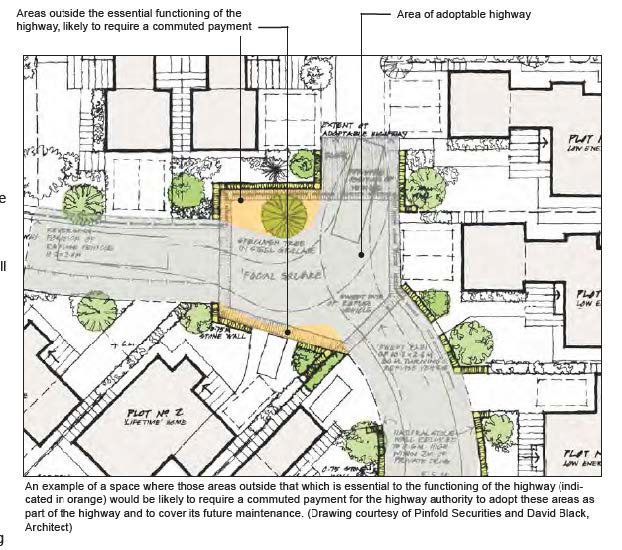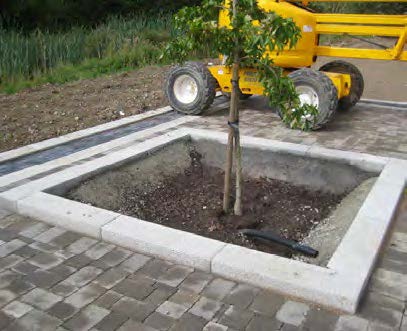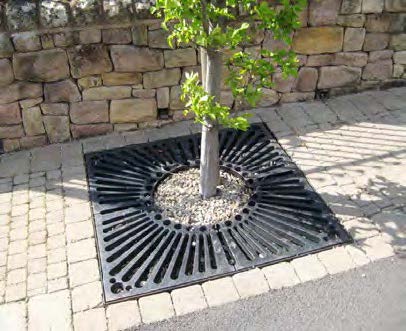Bolsover Successful Healthy Places SPD 2025
4. Management and Maintenance Good Urban Design Practice
4.1 Adoption and Management
4.1.1 Ensuring long term quality
The on-going management and maintenance of places is a key aspect of their long-term viability and quality. Our streets, parks and public spaces must provide high quality places that can be easily maintained at a reasonable cost. Maintenance issues and costs therefore need to be considered as part of the design process to ensure that maintainable schemes can be achieved and managed thereafter.
4.1.2 Funds spent on a good design and hard wearing materials can be saved through lower maintenance costs over the lifetime of the asset.
4.1.3 Adoption of highways
Developers should work closely with the planning and highway authorities during the design stages to ensure that their adoption requirements can be achieved without undermining the quality of the public realm. This is particularly important where schemes propose creative or non-standard design solutions in order to resolve any issues around adopting highways at an early stage.
4.1.4 Derbyshire County Council (DCC) is the highway authority for the area covered in this SPD. The Authority adopted Planning Streets and Places 2024. This guide details issues relating to the design and adoption of new roads.
4.1.5 In order to be adopted, all aspects of the public realm need to satisfy the technical requirements of the relevant adopting authority.
4.1.6 Safety and quality audits
The need for a safety audit should be discussed with the highway authority at an early stage. A safety audit is not normally required for streets designed and built for residential purposes, but may be prudent where a scheme proposes an innovative or non-standard design. This could be subject to a group professional review which includes a quality and safety audit. They are normally undertaken at each stage of the design process (feasibility, detailed design and on completion).
4.1.7 A quality audit addresses all aspects of street design including qualitative considerations. This normally includes their effectiveness for allowing movement of all traffic, including pedestrians, cyclists and people with impaired mobility as well as road safety, quality of place and visual appeal.
4.1.8 The format can be used to identity and resolve any issues that arise as part of the safety audit process. It provides the basis of a documented record for consideration of the issues, to demonstrate that these have been fully considered and appropriately addressed.
4.1.9 Swept path analysis
It may be necessary to demonstrate that the proposed junctions and turning areas are capable of accommodating the movements of service vehicles, buses and emergency vehicles. Applicants may be required to provide evidence in the form of swept path analysis to show that access and essential manoeuvres can be achieved in an acceptable way. This should be established at an early stage.
4.1.10 Road construction and materials must be capable of withstanding the loads and amount of traffic they will be expected to carry.
4.1.11 Commuted payments
4.1.12 If streets and public spaces are to be adopted the layout and selection of materials must be acceptable to the adopting highway authority.
4.1.13 If proposals include features that do not relate to essential highway functions of the street (such as alternative materials, street trees/ planting, extraneous areas of road space not necessary to the operation of road, as in a public square) the highway authority will need to be satisfied that such features do not place an additional unnecessary burden on maintenance budgets.
4.1.14 Where alternative materials or non-standard features are agreed in principle with the highway authority, it will normally be necessary to make a commuted payment to cover the additional costs that will be incurred in their future maintenance.
4.1.15 The Planning Streets and Places 2024 document details the requirements of the commuted sums policy. This covers a range of materials and features, including alternative materials and finishes such as block paving and surface dressings, bollards and street tree planting.
4.1.16 The appropriate mechanism for the payment of commuted sums related to highway requirements is normally via the section 38 and/or section 278 agreement process under the Highways Act 1980 (as amended).

4.2 Street trees and planting
4.2.1 Trees and soft landscape can make an important contribution to the appearance and character of a street, along with other environmental benefits.
4.2.2 The highway authority will require payment of a commuted sum towards future maintenance for each tree, shrub or area of planting that is proposed within the highway in order for it to be adopted (see Planning Streets and Places 2024 for details).
4.2.3 Separate approval is required from the highway authority for any landscape proposed within the highway. N/B this is in addition to any approval granted by the local planning authority for landscape that forms part of a planning permission or requirement by condition.
4.2.4 The selection of tree species and their siting within the street scene requires careful consideration and balancing of:
• Maintaining adequate visibility from junctions and accesses.
• The positioning of trees in relation to street lighting to avoid undue reduction in light levels.
• Avoiding conflict with existing or proposed utilities and drains.
• Maintaining reasonable levels of natural surveillance to frontages.
4.2.5 You are recommended to engage the services of a chartered landscape architect to advise and prepare suitable proposals for the landscape of the development. Further details on soft landscape and trees are set out in the Planning Streets and Places 2024 document and must comply with the required specifications.
4.2.6 This guidance sets out design considerations for tree planting, which includes:
• Excavation of tree planting pits and specification of the growing medium.
• Tree planting and staking.
• Grilles and guards in paved areas.
• Watering.
• Tree specifications.
• Establishment maintenance for new trees.
4.2.7 Maintenance of existing trees and vegetation.
4.2.8 Trees within the highway should provide sufficient planting space to enable the tree to become established, while maintaining a safe and functioning street and footway. Normally a 2m wide footway will need to be maintained, in addition to the area necessary for planting. Tree root barriers are also likely to be required to manage root spread, protect utilities and assist in maintaining even surfaces.


4.2.9 Managing Physical Assets
4.2.10 Where parks or public spaces are provided these may be adopted by the local authority (borough, district, town or parish) subject to the developer meeting obligations in respect of the transfer of the land in an appropriate condition and provision of commuted payments towards future maintenance. Such provisions are normally set out in a Section 106 legal agreement attached to the planning permission. Other physical assets, such as sustainable urban drainage systems (SuDs) would need to be adopted by the relevant responsible body.
4.2.11 Applicants should discuss adoption and management requirements with the local authority at an early stage to determine the necessary provisions for adoption and any likely commuted sums associated with its future management and maintenance.
4.2.12 If a developer does not propose to convey public spaces for adoption, it will be necessary to ensure that suitable alternative arrangements are put in place to secure its on-going management and maintenance.
4.2.13 In all cases the developer must make it clear how public spaces are to be managed and maintained (whether public or private) and put firm arrangements in place to demonstrate how this will be delivered. Undertakings should also be given that any spaces not adopted by a public body will remain publicly accessible.
4.2.14 Maintenance options by a non-public body could include:
• Maintenance by a Bonded Management Company.
• Maintenance by a Charitable Trust.
• Other solutions through special arrangement, such as maintenance by residents and/ or businesses, where it can be demonstrated to be a responsible, properly constituted body with the necessary capabilities and resources to fulfill its role.
4.2.15 Knowing how a place will be managed will influence how it is designed. The chosen management structure should have the appropriate skills and resources to manage the assets for which it is responsible, both now and into the future.
SuDs Maintenance
Rules on surface water sewers apply to all water and sewerage companies in England. The rules allow English water and sewerage companies to adopt a wide range of sewer types, including some SuDs.
It is advisable for developers and their consultants to give early consideration to the maintenance requirements for their SuDs scheme and potential routes for adoption. They should then also engage with the LPA and the Lead Local Flood Authority (LLFA) early on to explore mechanisms for adoption.
